University Project: Acute Aged Care in Public Hospitals
VerifiedAdded on 2022/08/12
|7
|1478
|20
Project
AI Summary
This project addresses the challenges of acute aged care within public hospitals, focusing on the increasing demands of an aging population in Australia. The project begins with a background on the Australian healthcare system, highlighting its strengths and affordability while acknowledging the growing strain on public resources due to the rise in the elderly population. The problem statement identifies the surge in demand for acute care services, leading to potential issues in providing adequate care for all patients, including young people. The project's goal is to develop alternative solutions to improve care for the aged population. Objectives include a focus on the aged population, measurable economic considerations, and realistic policy suggestions. Proposed outputs involve the creation of acute aged care homes with medical professionals, offering a homely environment. Outcomes include improved care for those with acute conditions and better attention for younger patients. Exclusions include increasing service costs. Assumptions include potential challenges with government understanding and the need for increased healthcare professionals. Constraints involve time-consuming government interaction and potential social discrimination concerns.
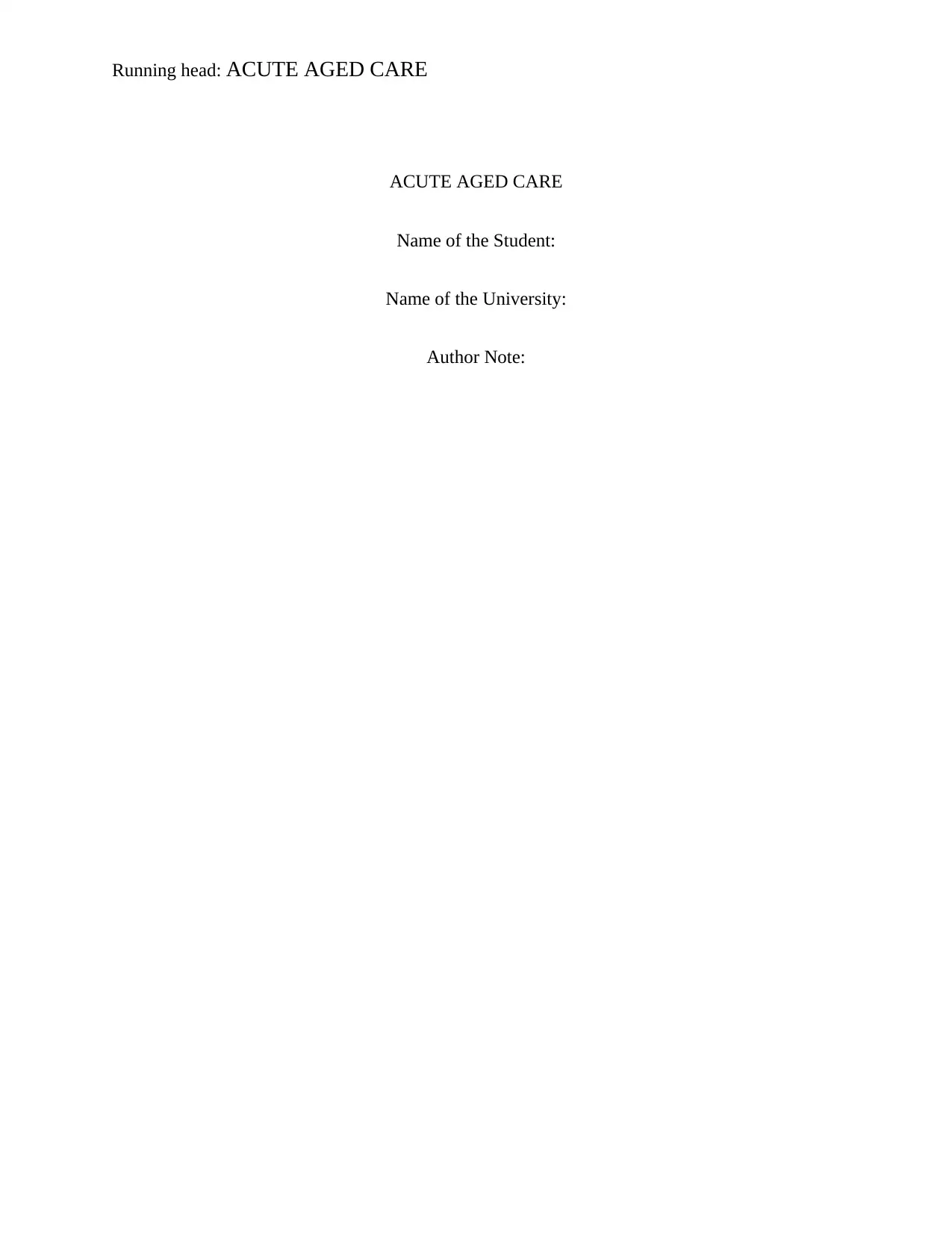
Running head: ACUTE AGED CARE
ACUTE AGED CARE
Name of the Student:
Name of the University:
Author Note:
ACUTE AGED CARE
Name of the Student:
Name of the University:
Author Note:
Paraphrase This Document
Need a fresh take? Get an instant paraphrase of this document with our AI Paraphraser
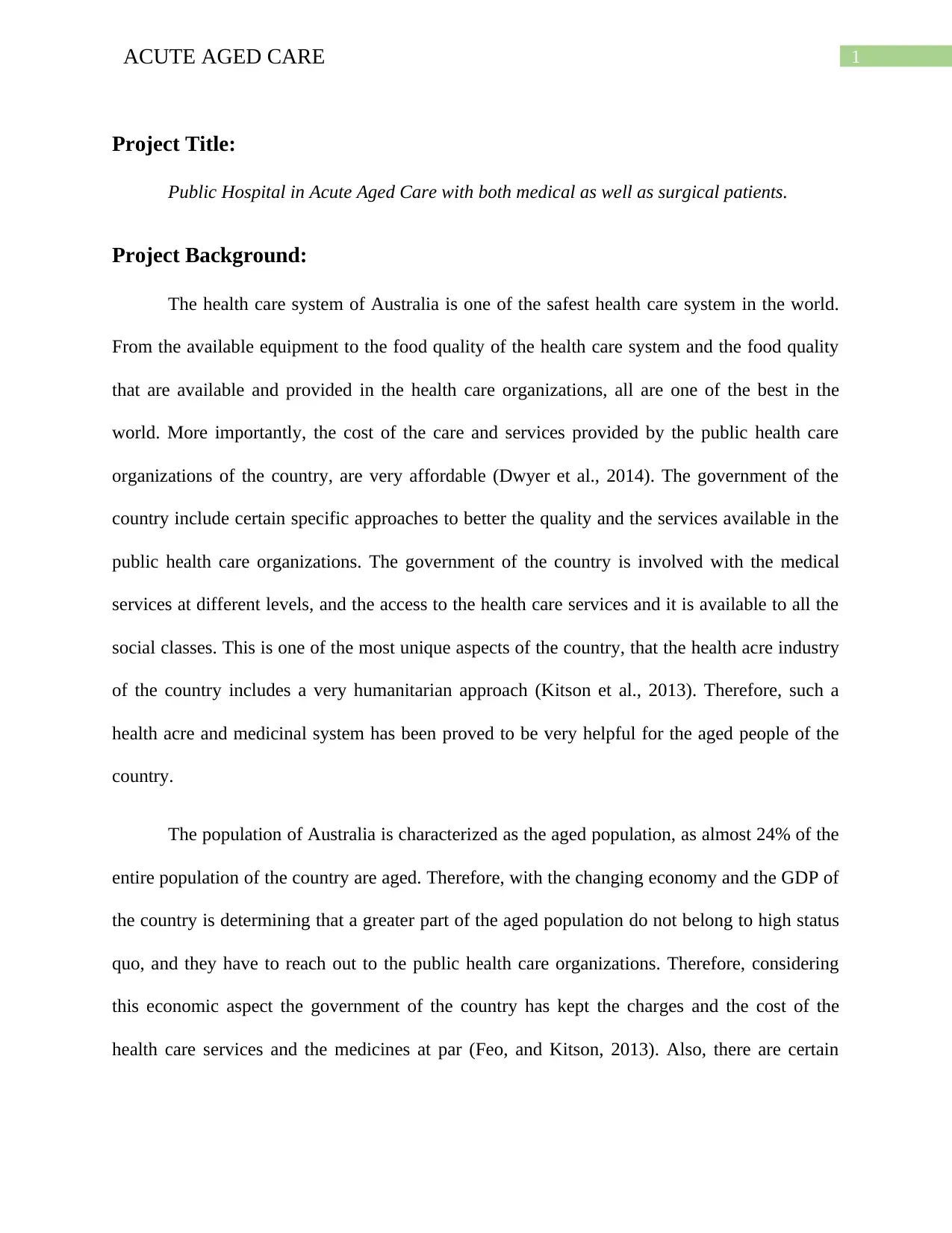
1ACUTE AGED CARE
Project Title:
Public Hospital in Acute Aged Care with both medical as well as surgical patients.
Project Background:
The health care system of Australia is one of the safest health care system in the world.
From the available equipment to the food quality of the health care system and the food quality
that are available and provided in the health care organizations, all are one of the best in the
world. More importantly, the cost of the care and services provided by the public health care
organizations of the country, are very affordable (Dwyer et al., 2014). The government of the
country include certain specific approaches to better the quality and the services available in the
public health care organizations. The government of the country is involved with the medical
services at different levels, and the access to the health care services and it is available to all the
social classes. This is one of the most unique aspects of the country, that the health acre industry
of the country includes a very humanitarian approach (Kitson et al., 2013). Therefore, such a
health acre and medicinal system has been proved to be very helpful for the aged people of the
country.
The population of Australia is characterized as the aged population, as almost 24% of the
entire population of the country are aged. Therefore, with the changing economy and the GDP of
the country is determining that a greater part of the aged population do not belong to high status
quo, and they have to reach out to the public health care organizations. Therefore, considering
this economic aspect the government of the country has kept the charges and the cost of the
health care services and the medicines at par (Feo, and Kitson, 2013). Also, there are certain
Project Title:
Public Hospital in Acute Aged Care with both medical as well as surgical patients.
Project Background:
The health care system of Australia is one of the safest health care system in the world.
From the available equipment to the food quality of the health care system and the food quality
that are available and provided in the health care organizations, all are one of the best in the
world. More importantly, the cost of the care and services provided by the public health care
organizations of the country, are very affordable (Dwyer et al., 2014). The government of the
country include certain specific approaches to better the quality and the services available in the
public health care organizations. The government of the country is involved with the medical
services at different levels, and the access to the health care services and it is available to all the
social classes. This is one of the most unique aspects of the country, that the health acre industry
of the country includes a very humanitarian approach (Kitson et al., 2013). Therefore, such a
health acre and medicinal system has been proved to be very helpful for the aged people of the
country.
The population of Australia is characterized as the aged population, as almost 24% of the
entire population of the country are aged. Therefore, with the changing economy and the GDP of
the country is determining that a greater part of the aged population do not belong to high status
quo, and they have to reach out to the public health care organizations. Therefore, considering
this economic aspect the government of the country has kept the charges and the cost of the
health care services and the medicines at par (Feo, and Kitson, 2013). Also, there are certain
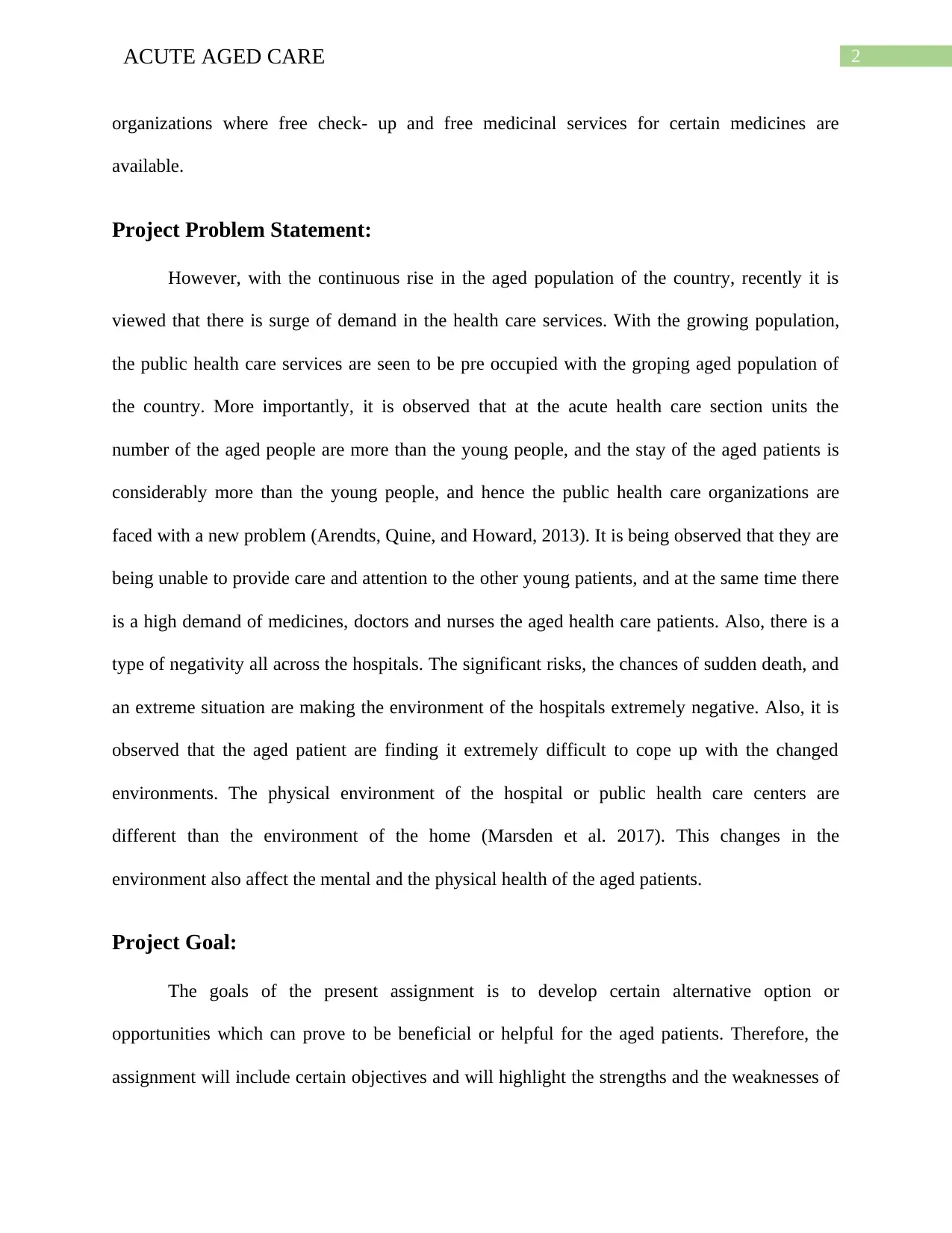
2ACUTE AGED CARE
organizations where free check- up and free medicinal services for certain medicines are
available.
Project Problem Statement:
However, with the continuous rise in the aged population of the country, recently it is
viewed that there is surge of demand in the health care services. With the growing population,
the public health care services are seen to be pre occupied with the groping aged population of
the country. More importantly, it is observed that at the acute health care section units the
number of the aged people are more than the young people, and the stay of the aged patients is
considerably more than the young people, and hence the public health care organizations are
faced with a new problem (Arendts, Quine, and Howard, 2013). It is being observed that they are
being unable to provide care and attention to the other young patients, and at the same time there
is a high demand of medicines, doctors and nurses the aged health care patients. Also, there is a
type of negativity all across the hospitals. The significant risks, the chances of sudden death, and
an extreme situation are making the environment of the hospitals extremely negative. Also, it is
observed that the aged patient are finding it extremely difficult to cope up with the changed
environments. The physical environment of the hospital or public health care centers are
different than the environment of the home (Marsden et al. 2017). This changes in the
environment also affect the mental and the physical health of the aged patients.
Project Goal:
The goals of the present assignment is to develop certain alternative option or
opportunities which can prove to be beneficial or helpful for the aged patients. Therefore, the
assignment will include certain objectives and will highlight the strengths and the weaknesses of
organizations where free check- up and free medicinal services for certain medicines are
available.
Project Problem Statement:
However, with the continuous rise in the aged population of the country, recently it is
viewed that there is surge of demand in the health care services. With the growing population,
the public health care services are seen to be pre occupied with the groping aged population of
the country. More importantly, it is observed that at the acute health care section units the
number of the aged people are more than the young people, and the stay of the aged patients is
considerably more than the young people, and hence the public health care organizations are
faced with a new problem (Arendts, Quine, and Howard, 2013). It is being observed that they are
being unable to provide care and attention to the other young patients, and at the same time there
is a high demand of medicines, doctors and nurses the aged health care patients. Also, there is a
type of negativity all across the hospitals. The significant risks, the chances of sudden death, and
an extreme situation are making the environment of the hospitals extremely negative. Also, it is
observed that the aged patient are finding it extremely difficult to cope up with the changed
environments. The physical environment of the hospital or public health care centers are
different than the environment of the home (Marsden et al. 2017). This changes in the
environment also affect the mental and the physical health of the aged patients.
Project Goal:
The goals of the present assignment is to develop certain alternative option or
opportunities which can prove to be beneficial or helpful for the aged patients. Therefore, the
assignment will include certain objectives and will highlight the strengths and the weaknesses of
⊘ This is a preview!⊘
Do you want full access?
Subscribe today to unlock all pages.

Trusted by 1+ million students worldwide
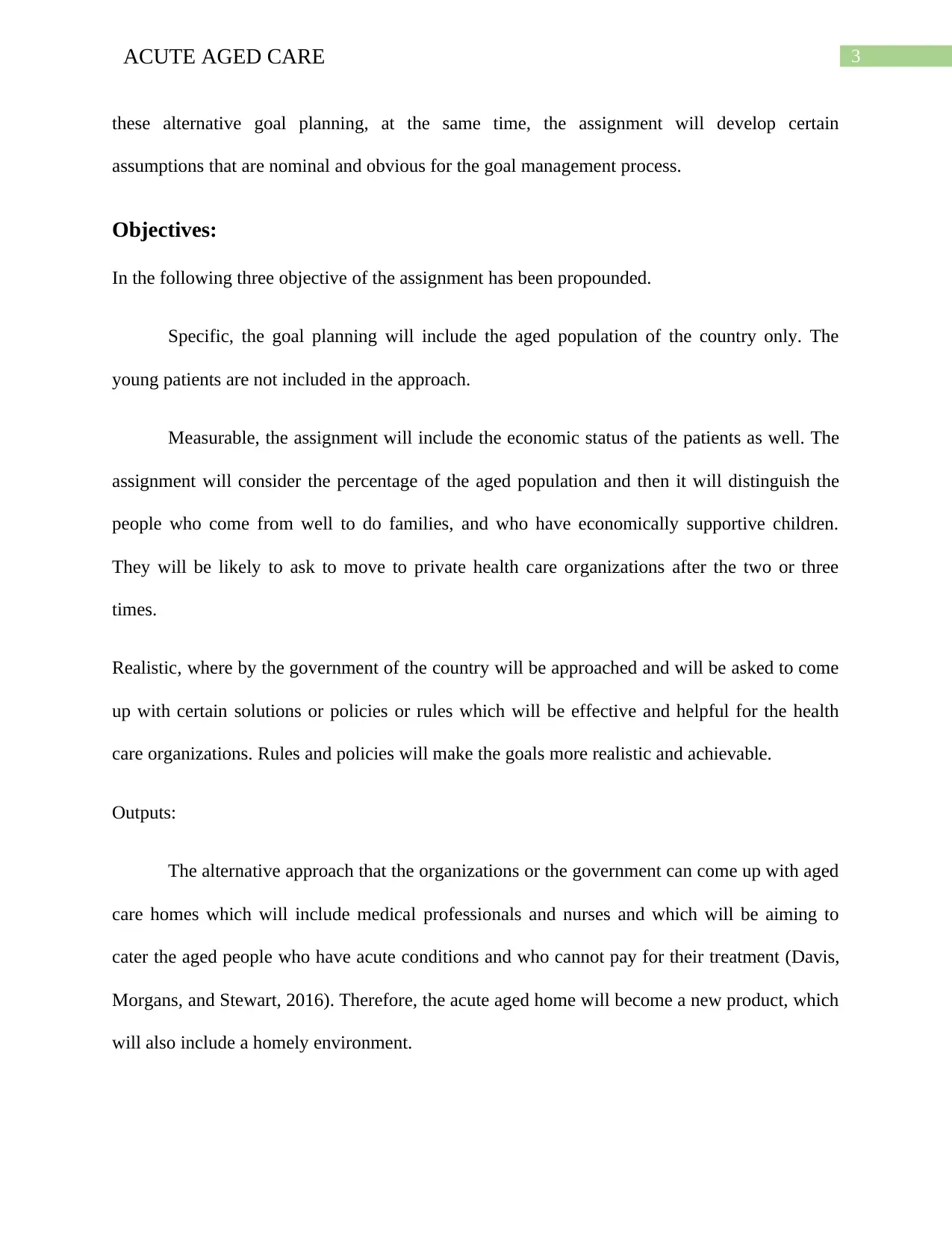
3ACUTE AGED CARE
these alternative goal planning, at the same time, the assignment will develop certain
assumptions that are nominal and obvious for the goal management process.
Objectives:
In the following three objective of the assignment has been propounded.
Specific, the goal planning will include the aged population of the country only. The
young patients are not included in the approach.
Measurable, the assignment will include the economic status of the patients as well. The
assignment will consider the percentage of the aged population and then it will distinguish the
people who come from well to do families, and who have economically supportive children.
They will be likely to ask to move to private health care organizations after the two or three
times.
Realistic, where by the government of the country will be approached and will be asked to come
up with certain solutions or policies or rules which will be effective and helpful for the health
care organizations. Rules and policies will make the goals more realistic and achievable.
Outputs:
The alternative approach that the organizations or the government can come up with aged
care homes which will include medical professionals and nurses and which will be aiming to
cater the aged people who have acute conditions and who cannot pay for their treatment (Davis,
Morgans, and Stewart, 2016). Therefore, the acute aged home will become a new product, which
will also include a homely environment.
these alternative goal planning, at the same time, the assignment will develop certain
assumptions that are nominal and obvious for the goal management process.
Objectives:
In the following three objective of the assignment has been propounded.
Specific, the goal planning will include the aged population of the country only. The
young patients are not included in the approach.
Measurable, the assignment will include the economic status of the patients as well. The
assignment will consider the percentage of the aged population and then it will distinguish the
people who come from well to do families, and who have economically supportive children.
They will be likely to ask to move to private health care organizations after the two or three
times.
Realistic, where by the government of the country will be approached and will be asked to come
up with certain solutions or policies or rules which will be effective and helpful for the health
care organizations. Rules and policies will make the goals more realistic and achievable.
Outputs:
The alternative approach that the organizations or the government can come up with aged
care homes which will include medical professionals and nurses and which will be aiming to
cater the aged people who have acute conditions and who cannot pay for their treatment (Davis,
Morgans, and Stewart, 2016). Therefore, the acute aged home will become a new product, which
will also include a homely environment.
Paraphrase This Document
Need a fresh take? Get an instant paraphrase of this document with our AI Paraphraser
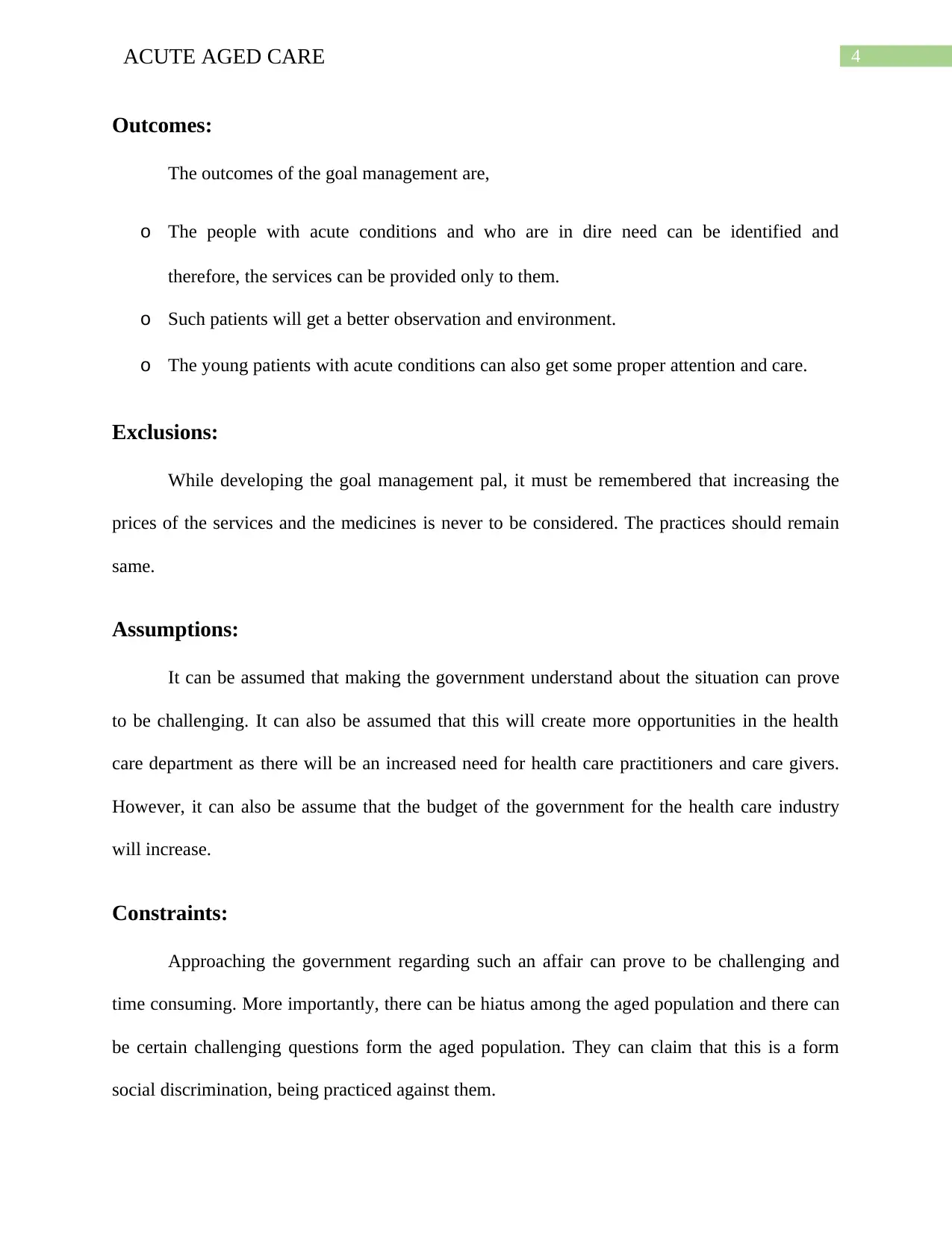
4ACUTE AGED CARE
Outcomes:
The outcomes of the goal management are,
o The people with acute conditions and who are in dire need can be identified and
therefore, the services can be provided only to them.
o Such patients will get a better observation and environment.
o The young patients with acute conditions can also get some proper attention and care.
Exclusions:
While developing the goal management pal, it must be remembered that increasing the
prices of the services and the medicines is never to be considered. The practices should remain
same.
Assumptions:
It can be assumed that making the government understand about the situation can prove
to be challenging. It can also be assumed that this will create more opportunities in the health
care department as there will be an increased need for health care practitioners and care givers.
However, it can also be assume that the budget of the government for the health care industry
will increase.
Constraints:
Approaching the government regarding such an affair can prove to be challenging and
time consuming. More importantly, there can be hiatus among the aged population and there can
be certain challenging questions form the aged population. They can claim that this is a form
social discrimination, being practiced against them.
Outcomes:
The outcomes of the goal management are,
o The people with acute conditions and who are in dire need can be identified and
therefore, the services can be provided only to them.
o Such patients will get a better observation and environment.
o The young patients with acute conditions can also get some proper attention and care.
Exclusions:
While developing the goal management pal, it must be remembered that increasing the
prices of the services and the medicines is never to be considered. The practices should remain
same.
Assumptions:
It can be assumed that making the government understand about the situation can prove
to be challenging. It can also be assumed that this will create more opportunities in the health
care department as there will be an increased need for health care practitioners and care givers.
However, it can also be assume that the budget of the government for the health care industry
will increase.
Constraints:
Approaching the government regarding such an affair can prove to be challenging and
time consuming. More importantly, there can be hiatus among the aged population and there can
be certain challenging questions form the aged population. They can claim that this is a form
social discrimination, being practiced against them.
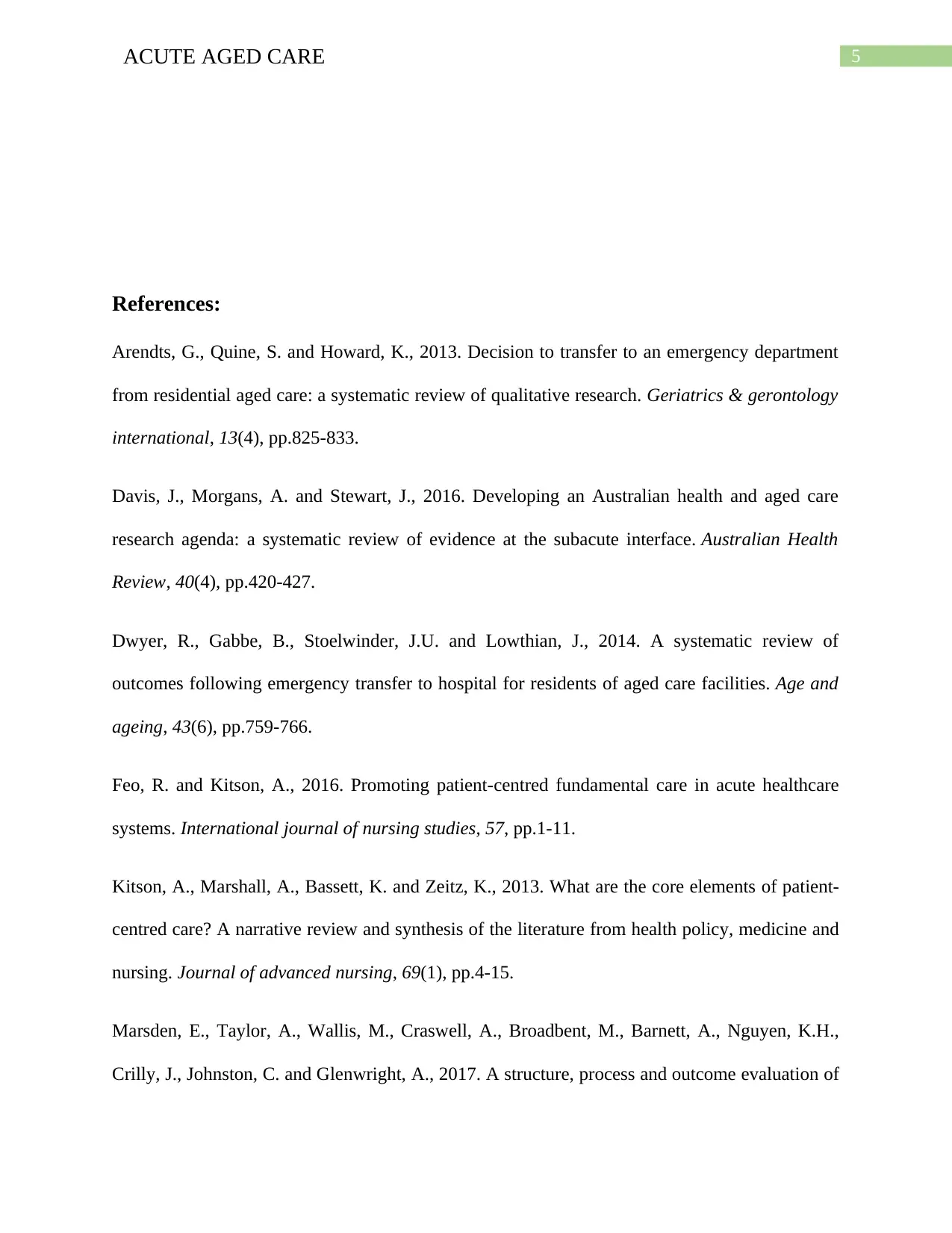
5ACUTE AGED CARE
References:
Arendts, G., Quine, S. and Howard, K., 2013. Decision to transfer to an emergency department
from residential aged care: a systematic review of qualitative research. Geriatrics & gerontology
international, 13(4), pp.825-833.
Davis, J., Morgans, A. and Stewart, J., 2016. Developing an Australian health and aged care
research agenda: a systematic review of evidence at the subacute interface. Australian Health
Review, 40(4), pp.420-427.
Dwyer, R., Gabbe, B., Stoelwinder, J.U. and Lowthian, J., 2014. A systematic review of
outcomes following emergency transfer to hospital for residents of aged care facilities. Age and
ageing, 43(6), pp.759-766.
Feo, R. and Kitson, A., 2016. Promoting patient-centred fundamental care in acute healthcare
systems. International journal of nursing studies, 57, pp.1-11.
Kitson, A., Marshall, A., Bassett, K. and Zeitz, K., 2013. What are the core elements of patient‐
centred care? A narrative review and synthesis of the literature from health policy, medicine and
nursing. Journal of advanced nursing, 69(1), pp.4-15.
Marsden, E., Taylor, A., Wallis, M., Craswell, A., Broadbent, M., Barnett, A., Nguyen, K.H.,
Crilly, J., Johnston, C. and Glenwright, A., 2017. A structure, process and outcome evaluation of
References:
Arendts, G., Quine, S. and Howard, K., 2013. Decision to transfer to an emergency department
from residential aged care: a systematic review of qualitative research. Geriatrics & gerontology
international, 13(4), pp.825-833.
Davis, J., Morgans, A. and Stewart, J., 2016. Developing an Australian health and aged care
research agenda: a systematic review of evidence at the subacute interface. Australian Health
Review, 40(4), pp.420-427.
Dwyer, R., Gabbe, B., Stoelwinder, J.U. and Lowthian, J., 2014. A systematic review of
outcomes following emergency transfer to hospital for residents of aged care facilities. Age and
ageing, 43(6), pp.759-766.
Feo, R. and Kitson, A., 2016. Promoting patient-centred fundamental care in acute healthcare
systems. International journal of nursing studies, 57, pp.1-11.
Kitson, A., Marshall, A., Bassett, K. and Zeitz, K., 2013. What are the core elements of patient‐
centred care? A narrative review and synthesis of the literature from health policy, medicine and
nursing. Journal of advanced nursing, 69(1), pp.4-15.
Marsden, E., Taylor, A., Wallis, M., Craswell, A., Broadbent, M., Barnett, A., Nguyen, K.H.,
Crilly, J., Johnston, C. and Glenwright, A., 2017. A structure, process and outcome evaluation of
⊘ This is a preview!⊘
Do you want full access?
Subscribe today to unlock all pages.

Trusted by 1+ million students worldwide
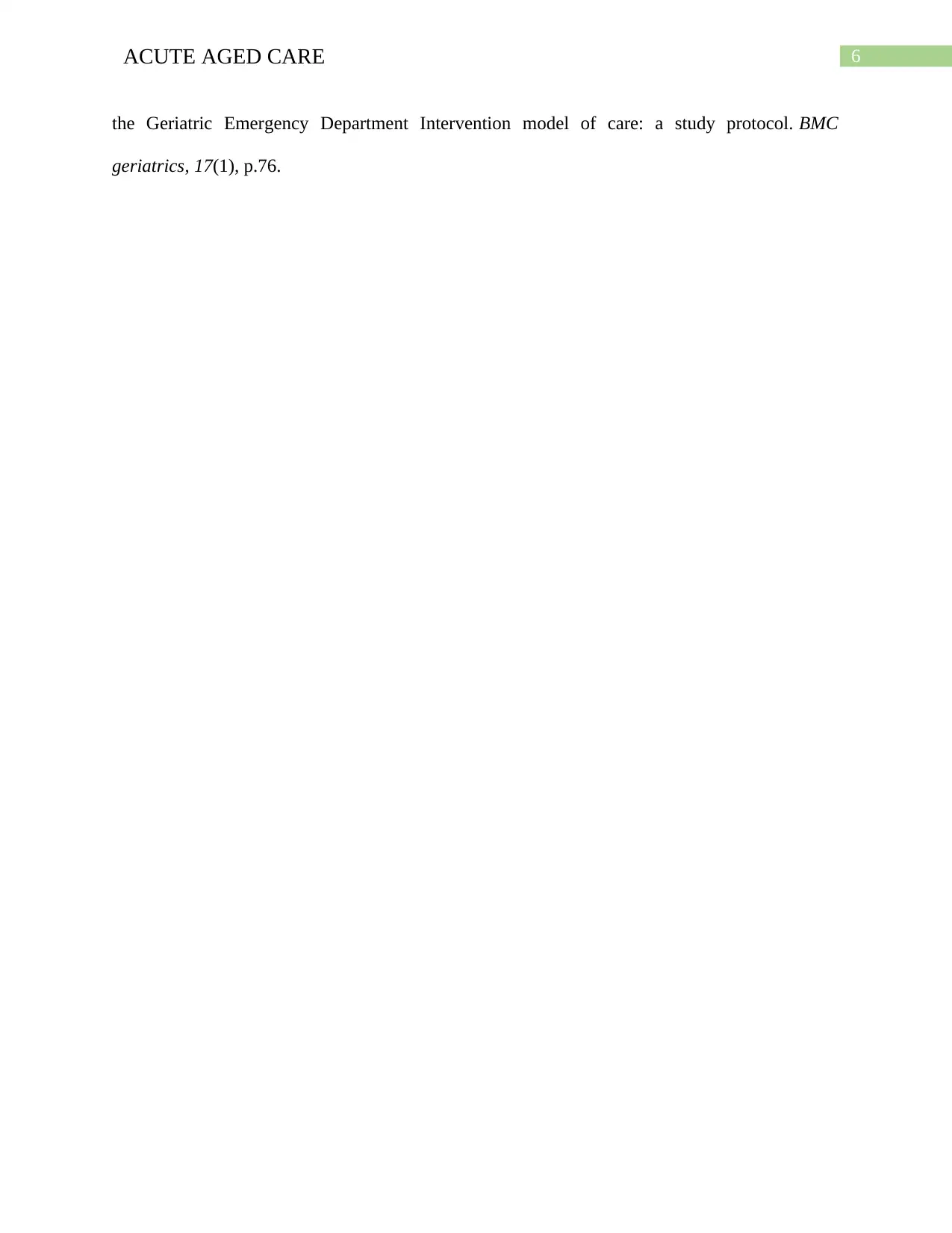
6ACUTE AGED CARE
the Geriatric Emergency Department Intervention model of care: a study protocol. BMC
geriatrics, 17(1), p.76.
the Geriatric Emergency Department Intervention model of care: a study protocol. BMC
geriatrics, 17(1), p.76.
1 out of 7
Related Documents
Your All-in-One AI-Powered Toolkit for Academic Success.
+13062052269
info@desklib.com
Available 24*7 on WhatsApp / Email
![[object Object]](/_next/static/media/star-bottom.7253800d.svg)
Unlock your academic potential
Copyright © 2020–2025 A2Z Services. All Rights Reserved. Developed and managed by ZUCOL.





